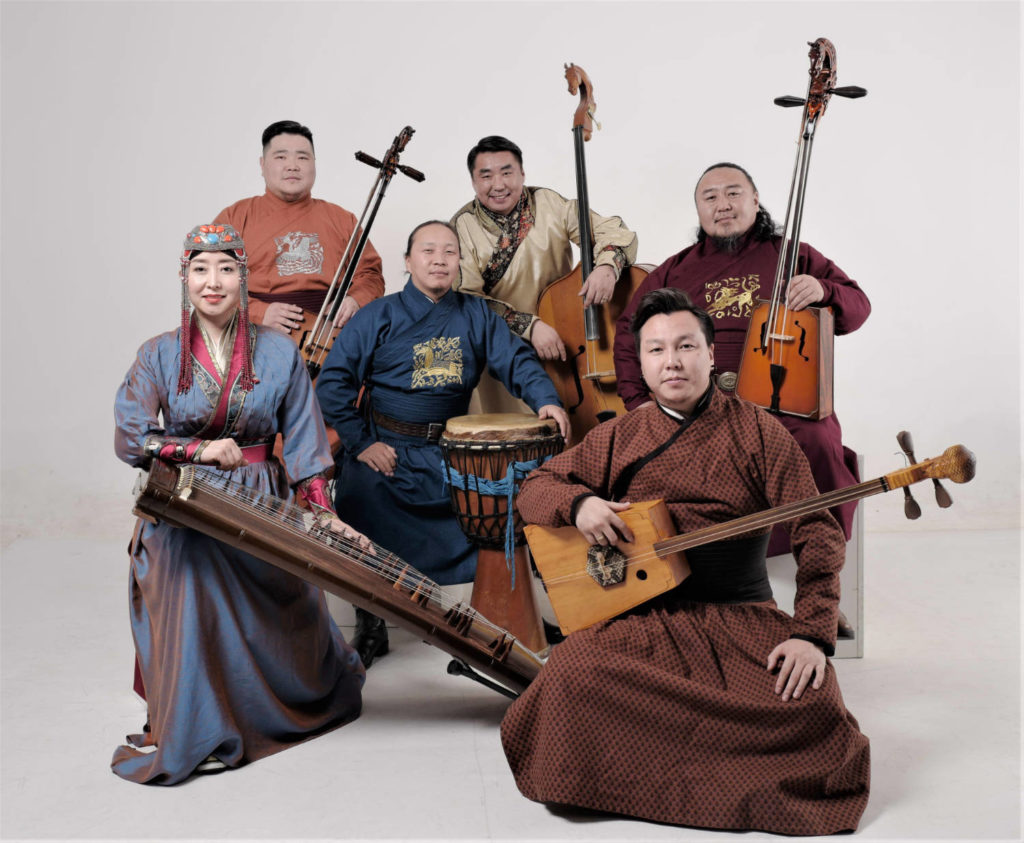Musicians
Ariunbold Dashdorj : vocals / khöömii / big fiddle horse ikh khuur / guitar
Batzorig Vaanchig : vocals / khöömii / fiddle horse morin khuur
Amarbayasgalan Chovjoo : choirs / yatga zither
Chuluunbaatar Oyungerel : vocals / khöömii / fiddle horse morin khuur
Ulambayar Khurelbaatar : vocals / khöömii / dombra lute
Adiyadorj Gombosuren : vocals / khöömii / flute and percussions
If Khusugtun were a picture, it would be petroglyphs … If it was a natural element, it would be a river. If that was a character, it would be Jangar, the hero of the eponymous epic.
In Mongolian “khusug” means a cart on which yurts were once placed to nomadize. Khusugtun would mean “the people of the chariots”. Intimately linked to their nomadic culture, this term is synonymous with “nomads” for these musicians who have been touring internationally for ten years. This name was chosen based on their desire to nomadize with their music, like their ancestors who traveled the world. The band, officially formed in March 2009, had so far only one self-produced album to their credit: Khusugtun. Ethnic-Ballad Group (Ulaanbaatar, 2009).
What sets Khusugtun apart is the use of vocal polyphony made from khöömii and various throat songs, as well as a repertoire almost entirely dedicated to Mongolian overtone singing (khöömii). Specific to each one, the overtone timbres complement each other wonderfully: Chulunbaatar is in the highest register (isgeree khöömii – whistled khöömii), Ariunbold, Adiyadorj and Ulambayar are in the mediums, Batzorig in the lowest register (kharkhiraa – khöömii deep). Amarbayasgalan is not overwhelming, but her soft feminine voice brings lightness to the spectrum filled with the other five, creating the necessary balance.
The group is accompanied by the fiddle horse (morin khuur), their double bass version (ikh khuur), the tovshuur lute, the dombra lute, guitar, cello, and yatga zither. There are also overtone playing instruments, such as the metal jaw harp (tömör khuur) and bamboo (khulsan khuur) as well as the musical bow (numan khuur). This instrument had fallen into oblivion and Khusugtun is bringing it up to date here. Khusugtun has chosen the djembe for percussion – an iconic instrument of World Music – to create pieces that appeal to young people, so that this generation is interested in traditional music.
Their repertoire consists of traditional forms, such as praise songs (magtaal), short songs (bogino duu), or compositions inspired by tradition, and solo instrumental pieces (tatlaga) to accompany the bii biyelgee dance.
After their association in 2009, many bands have appeared all over Mongolia and into Inner Mongolia in China, playing traditional music arranged almost identically. After being revealed by the Khöömii International Festival in Ulaanbaatar in 2009, BBC Proms in 2011, Rainforest Music Festival in 2012, and ranked 2nd at Asia’s Got Talent in 2015, Khusugtun has now gained international fame. He also became one of the influences of the phenomenon group The Hu.
From its beginnings the group characterized its style by melodious tunes intended to purify people of the ambient stress of the XXIst century. What matters to them is that we listen to them while imagining the landscape, the beauty of nature, to free themselves from daily worries. Thanks to an unparalleled level of interpretation, their powerful music filled with wide open spaces makes us feel good.
Discographie
- New album, Jangar, released on Buda Musique label, August 28th 2020
- Une Anthologie du khöömii mongol (Routes Nomades/Buda Musique, 2017)
- Khusugtun. Ethnic-Ballad Group (autoproduction, Ulaanbaatar, 2009)

